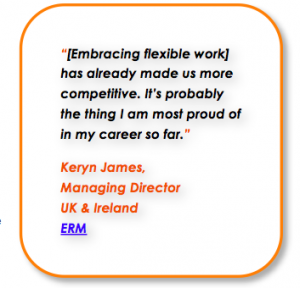 When you look for a job, you’ll want to target organizations and companies with workplaces and cultures conducive to your lifestyle. If you’re looking for a job with some flexibility, you are in good company. [Read more…] about 10 tips if you are looking for a flexible job
When you look for a job, you’ll want to target organizations and companies with workplaces and cultures conducive to your lifestyle. If you’re looking for a job with some flexibility, you are in good company. [Read more…] about 10 tips if you are looking for a flexible job
Important information about work-life fit/flexibility
 One issue for many job seekers is landing an opportunity offering “flexibility,” “balance,” or, what consultant, Cali Williams Yost, CEO and Founder of Flex Strategy Group and author of Work+Life: Finding the Fit That’s Right for You, would call “work-life fit.”
One issue for many job seekers is landing an opportunity offering “flexibility,” “balance,” or, what consultant, Cali Williams Yost, CEO and Founder of Flex Strategy Group and author of Work+Life: Finding the Fit That’s Right for You, would call “work-life fit.”
Today, I’m happy to share research Cali sent me from from the 2011 Work+Life Fit™ Reality Check Survey. It illustrates that, “Work life flexibility is no longer a bright, shiny, novelty item that only a few people have. In fact, most full-time employees have some form of work life flexibility and they are much less afraid to use it than they were five years ago.”
The following tips are directly from survey findings to help you get the most out of the work life flexibility that’s become a foundational part of the way we live and work:
Tip 1: Don’t let too much work and too little time keep you from work life flexibility, instead use that flexibility strategically to get your work done and have a life. When asked, respondents ranked “increased workload or no time for flexibility” as the top obstacle (29%) that kept them from using or improving their work life flexibility. Looked at another way, flexibility could also be the key to managing that greater workload and having more time for the other parts of your life. A periodic shift in hours, or working from home now and then could restore a sense of productivity and well-being. Be creative.
Tip 2: Remember that work life flexibility comes in many forms. It includes both day-to-day, informal ad hoc shifts in how, when and where you work, as well as formal plans that officially change your work+life fit. Even though 62% of respondents said they had some type of day-to-day, ad hoc flexibility, it’s easy to take it for granted as a given. Use it thoughtfully and strategically to manage the way work fits into your life every day. If you are interested in more formal plan, learn ahead of time how to present a proposal that’s a win for you and the business.
Tip 3: To make informal, day-to-day flexibility a success for you, your team and the business, make sure to communicate and coordinate with all of the key stakeholders, not just your supervisor. According to the survey, when respondents made occasional changes in how, when and where they work, they discussed those changes with:
- 79% their supervisor
- 63% their spouse, family or partner
- 52% their colleagues
- 45% those they supervise, and
- 7% no one.
You don’t need to tell your colleagues and those you supervise why you are using flexibility, but let them know how the work will get done and how they can reach you if needed.
Tip 4: Challenge any lingering fears that may be keeping you from using or improving your work life flexibility. Make sure any fear or concern is based on fact, not invalid assumptions. The good news is that individuals are much less likely to let fear or negative perceptions keep them from using or improving their flexibility than they were in 2006:
- You might make less money: 21% in 2011 versus 45% in 2006
- You might lose your job: 16% in 2011 versus 28% in 2006
- Others will think you don’t work hard: 11% in 2011 versus 39% in 2006
- You worry that your boss would say “no”: 13% in 2011 versus 32% in 2006
However, obviously some fears and concerns linger. Learn about the compensation policy related to flexibility where you aren’t working less, just differently.  Understand the employment climate in your organization. Make sure you continue to work hard, communicate and coordinate well (see Tip 3) and learn how to present a flexibility plan that’s a win-win and hard to turn down.
Tip 5: Understand that work life flexibility is more than a perk, or benefit. It’s a strategy that your employer can use to “retain talent, manage workload and grow.” And without it, the business will suffer particularly in the areas of health/wellness, morale and productivity. One of the surprising findings for the 2011 Work+Life Fit Reality Check is how many respondents either think work life flexibility is a “perk or benefit” (36%) or “don’t know” what it is (14%). Just as work life flexibility can help you strategically manage your workload and resources, it can also benefit the business in other areas. Specifically, a majority of respondents (66%) felt that without work life flexibility health (48%), morale (41%) and productivity (36%) would suffer.
For more details and to download the study, visit Work Life Fit Tips.
You may also want to read a study addressing the issue of inevitability of work-life flex, Findings from the Flexpaths – LinkedIn study.
photo by ellajphillips
Are flexible work environments inevitable?
 Can you imagine being asked to select your work style at the same time as you choose your benefits package when starting a new job? Neither can I! However, a new study, Flexible Work: Perceptions & Realities — Findings from the Flexpaths – LinkedIn Virtual Think Tanks December 2010, suggests this seemingly impossible scenario may become a reality. (Take a look at the entire whitepaper, embedded at the end of this post.)
Can you imagine being asked to select your work style at the same time as you choose your benefits package when starting a new job? Neither can I! However, a new study, Flexible Work: Perceptions & Realities — Findings from the Flexpaths – LinkedIn Virtual Think Tanks December 2010, suggests this seemingly impossible scenario may become a reality. (Take a look at the entire whitepaper, embedded at the end of this post.)
The study was significant because, of the 45 participants in the research groups, 24 were managing directors or CEOs (mostly from companies with 200-700 employees) and 16 were senior Human Resources leaders (mostly from companies with over 1,000 employees).
It’s not surprising to learn that a commonality between all of the companies represented was an array of cultural obstacles to embracing a truly flexible workplace. Even defining “flexible work” was a challenge. Participants suggested several approaches, including:
- Flexibility Around “When†– working non-traditional hours and compressed workweeks
- Flexibility Around “Where†– involving telecommuting/telework
- Flexibility Around “How Much†– inviting workers to share job hours, reducing hours in exchange for less pay, sabbaticals, etc.
- Flexibility Around “How†– incorporating freelance and contract workers
Few of the think tank participants had formal policies to govern flexible work, but a main impetus for making flexibility a part of their plans was “attracting and retaining top talent.” The study notes, “Several (participants) remarked upon how saving even a couple of high performers from leaving had more than paid for their flexible work initiatives.”
 Additionally, several CEOs noted they want to attract the best Generation Y talent, which is driving their interest in a flexible workplace. Some saw a shift in their approach to flexibility as being customer service focused and others acknowledged that having flexibility helped engage workers.
Additionally, several CEOs noted they want to attract the best Generation Y talent, which is driving their interest in a flexible workplace. Some saw a shift in their approach to flexibility as being customer service focused and others acknowledged that having flexibility helped engage workers.
A majority of participants expect flexible work arrangements to be an important factor to remaining competitive, suggesting “significant increases in the proportion of their workforces that would be engaging in flexible work” by 2015. Some thought it would be as high as 80% of their workforce, but most predicted around 50% of their employees may take advantage of flexible work options by that time. (Compared to 25% currently.)
No doubt, significant changes will be necessary to achieve those percentages, as participants recognized that flexible work appeals to a lot of workers, but “employees are afraid that requesting flexible work will jeopardize their career opportunities.”
Barriers to a truly flexible workplace mentioned in the study include:
- Fear of lost control and lack of trust (on the employer’s part)
- Losing a team spirit (if people don’t work face-to-face)
- Legal issues
- Measuring success and rewarding results – how to manage flexible workers without sacrificing quality
(The entire whitepaper is available at the end of this post for your review.)
If a flexible work arrangement appeals to you, here are some tips from Cali Williams Yost, author of Work+Life: Finding the Fit That’s Right for You (Riverhead, Penguin Group, 2005):
Three Fool-Proof Tips for Making Flexible Work a Success
Tip 1: Don’t expect your manager to come up with a solution. Start the conversation with him or her by presenting a clear flexibility plan that specifies the:
- Type of flexibility you are proposing
- How the work will get done (not “why†you want flexibility—it doesn’t matter)
- How the business will benefit from your plan, and
- When the plan will be reviewing (e.g. initially 90 days; annually thereafter)
Tip 2: Remember that it’s your job to (over) communicate with your boss, your team and your clients.
When you are out-of-sight because either you work from home or work flexible, non-traditional hours, be mindful of consistent accessibility and reliability:
- If you aren’t immediately reachable, make it a priority to check messages regularly and respond in a timely manner.
- Initiate a “check in†by email, IM or phone once or twice during the day with your team or your manager to see if there is anything you need to be aware of. Most likely there won’t be, but they will appreciate the extra effort.
- Each week, put together one-page of highlights of accomplishments. In today’s economy, we should all have a record of what we’ve done…not just flex workers! It comes in handy when negotiating for a raise or promotion.
Tip 3: Be flexible with your flexibility.
Nothing causes a manager or a coworker to lose patience with your flexibility faster than a consistent unwillingness to periodically “go the extra mile.†If there’s an unexpected deadline and it’s your time to leave, offer to stay now and then. If you’re scheduled to work from home, offer to come into the office if it’s the only day a client can meet.
Taking the initiative, being conscientious and going the extra mile (from time to time), are small actions that go a long way to making your flexibility work for everyone.
ABOUT FLEXPATHS LLC
FlexPaths® is a leading global provider of web-based software solutions and advisory services that help companies create and leverage a flexible working culture. You can find them on Twitter, Facebook and LinkedIn.
ABOUT CALI WILLIAMS YOST
Cali is the CEO of the Flex+Strategy Group / Work+Life Fit, Inc., a flexibility strategy consulting firm. In addition to her book, Work+Life: Finding the Fit That’s Right for You (Riverhead/Penguin Group, 2005), Yost created the award-winning Work+Life Fit blog, and is an expert blogger for FastCompany.com. You can follow her on Twitter @caliyost.
Flexpaths & LinkedIn Present Think Tank Findings, Flexible Work: Perceptions & Realities
